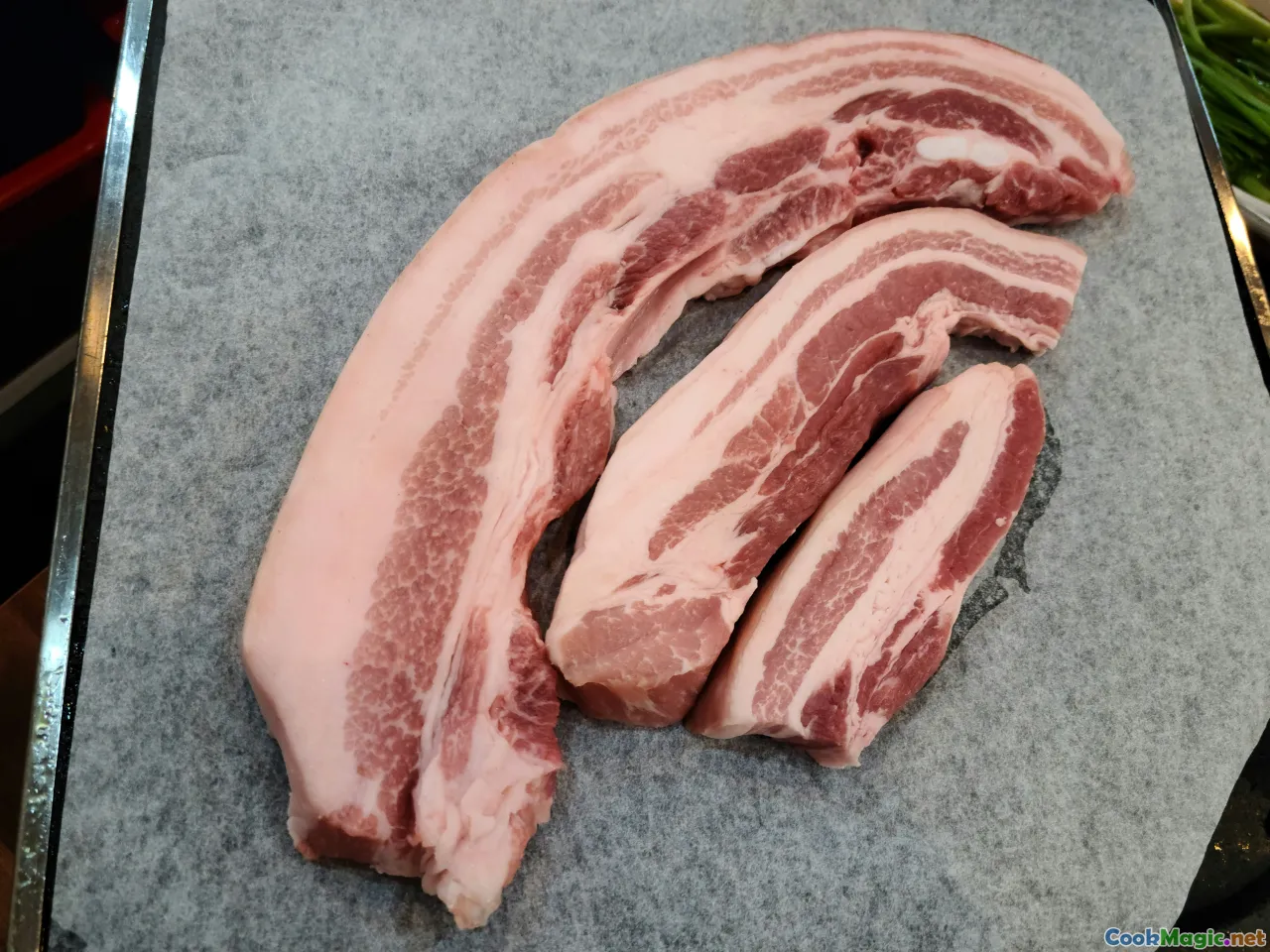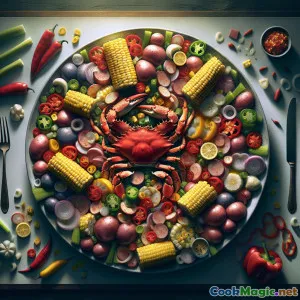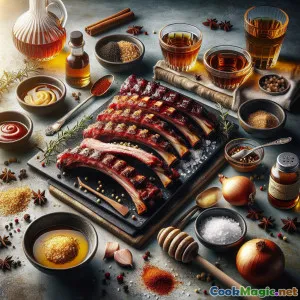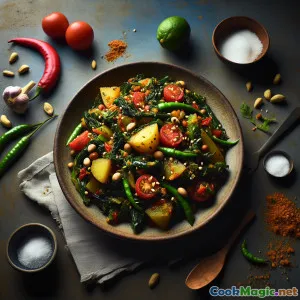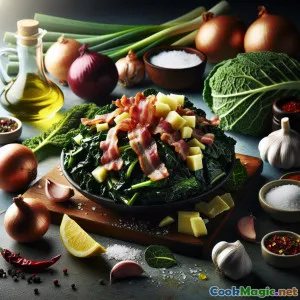
Chou cavalier du Sud à la poêle avec bacon croustillant
(Southern Skillet Collard Greens with Crispy Bacon)
(0 Avis)0
856
juillet 16, 2025
Signaler un problème
Ingrédients
-
500 grams Chou cavalier
(Feuilles fraîches, tiges épaisses retirées et hachées)
-
150 grams Bacon
(fumé, coupé en petits morceaux)
-
1 medium Oignon jaune
(Haché finement)
-
3 cloves Ail
(Haché)
-
2 tbsp Vinaigre de cidre de pomme
(Donne de l'éclat aux légumes verts.)
-
400 ml bouillon de poulet
(Peut être remplacé par du bouillon de légumes pour une option végétarienne.)
-
1 tbsp Huile d'olive
(Sublime les saveurs, notamment pour rendre le bacon croustillant.)
-
0.5 tsp Flocons de piment rouge
(Optionnel, pour une légère touche de piquant.)
-
0.5 tsp Sel
(Goûter et ajuster si nécessaire.)
-
0.5 tsp Poivre noir
(Poivre fraîchement concassé ou moulu)
(Feuilles fraîches, tiges épaisses retirées et hachées)
(fumé, coupé en petits morceaux)
(Haché finement)
(Haché)
(Donne de l'éclat aux légumes verts.)
(Peut être remplacé par du bouillon de légumes pour une option végétarienne.)
(Sublime les saveurs, notamment pour rendre le bacon croustillant.)
(Optionnel, pour une légère touche de piquant.)
(Goûter et ajuster si nécessaire.)
(Poivre fraîchement concassé ou moulu)
Nutrition
- Portions: 4
- Taille de portion: 1 bol (200g)
- Calories: 195 kcal
- Carbohydrates: 10 g
- Protein: 11 g
- Fat: 12 g
- Fiber: 4 g
- Sugar: 2 g
- Sodium: 550 mg
- Cholesterol: 25 mg
- Calcium: 130 mg
- Iron: 1.8 mg
Instructions
-
1 - Prépare les feuilles de chou vert.:
Enlevez les grosses tiges des feuilles de collard. Rincez abondamment, puis empilez-les, roulez-les et coupez les feuilles en fines rubans.
-
2 - Rends le bacon croustillant:
Ajoutez de l'huile d'olive dans une grande poêle et faites chauffer à feu moyen. Faites cuire les morceaux de bacon jusqu'à ce qu'ils soient croustillants, environ 5 à 7 minutes. Retirez-les avec une écumoire et réservez, en laissant la graisse rendue dans la poêle.
-
3 - Faire sauter oignon et ail:
Ajoutez l'oignon en dés dans la poêle avec le gras de bacon. Faites revenir jusqu'à ce que l'oignon soit tendre, environ 3 minutes, puis incorporez l'ail et faites revenir pendant 1 minute jusqu'à ce que ce soit parfumé.
-
4 - Faites cuire les feuilles de chou vert:
Ajoutez des feuilles de collard dans la poêle. Remuez pour les enrober et faites cuire 2–3 minutes. Versez le bouillon de poulet, portez à ébullition légère, couvrez et laissez cuire 10–12 minutes, en remuant de temps en temps, jusqu'à ce que les feuilles soient tendres.
-
5 - Assaisonnez et ajoutez du bacon.:
Retirez le couvercle. Ajoutez le vinaigre de cidre, des flocons de piment rouge (si vous en utilisez), du sel et du poivre noir. Replacez le bacon dans la poêle et mélangez bien le tout. Laissez mijoter à découvert jusqu'à ce que la plupart du liquide s'évapore.
-
6 - Servir:
Goûtez pour ajuster l'assaisonnement, puis transférez les feuilles de chou collard avec du bacon dans des bols de service. Servez chaud en accompagnement ou pour un déjeuner copieux.
Enlevez les grosses tiges des feuilles de collard. Rincez abondamment, puis empilez-les, roulez-les et coupez les feuilles en fines rubans.
Ajoutez de l'huile d'olive dans une grande poêle et faites chauffer à feu moyen. Faites cuire les morceaux de bacon jusqu'à ce qu'ils soient croustillants, environ 5 à 7 minutes. Retirez-les avec une écumoire et réservez, en laissant la graisse rendue dans la poêle.
Ajoutez l'oignon en dés dans la poêle avec le gras de bacon. Faites revenir jusqu'à ce que l'oignon soit tendre, environ 3 minutes, puis incorporez l'ail et faites revenir pendant 1 minute jusqu'à ce que ce soit parfumé.
Ajoutez des feuilles de collard dans la poêle. Remuez pour les enrober et faites cuire 2–3 minutes. Versez le bouillon de poulet, portez à ébullition légère, couvrez et laissez cuire 10–12 minutes, en remuant de temps en temps, jusqu'à ce que les feuilles soient tendres.
Retirez le couvercle. Ajoutez le vinaigre de cidre, des flocons de piment rouge (si vous en utilisez), du sel et du poivre noir. Replacez le bacon dans la poêle et mélangez bien le tout. Laissez mijoter à découvert jusqu'à ce que la plupart du liquide s'évapore.
Goûtez pour ajuster l'assaisonnement, puis transférez les feuilles de chou collard avec du bacon dans des bols de service. Servez chaud en accompagnement ou pour un déjeuner copieux.
En savoir plus sur: Chou cavalier du Sud à la poêle avec bacon croustillant
Collard Greens with Bacon — Southern Tradition in Every Bite
Collard greens have a deeply rooted history in Southern American cuisine, stretching back over generations and oceans. Originating in Africa and Europe, leafy greens like collards became staple crops across the southern United States due to their resilient nature and hearty, nutritious leaves. Collard greens with bacon is an iconic dish—earthy greens slow-simmered until melt-in-your-mouth tender, enriched with smoky bacon, sweet onions, and spiked with a splash of vinegar to balance the richness.
History & Cultural Significance
For enslaved African Americans residing in the Antebellum South, collards were cultivated in gardens as essential sources of nutrition. Traditionally, they were slow-cooked with smoked meats (ham hocks, fatback, or bacon) to bring extra body and warmth, flavors that became emblematic of African American and Southern cuisine. Every Black family, and indeed, many white households in places like Georgia, the Carolinas, and Alabama developed their own approaches to seasoning, braising, and serving collard greens, often with personal or regional flourishes.
The custom of adding vinegar reflects West African cooking traditions, where acid is often used to brighten the intensity of long-cooked stews. Even today, a jar of peppered vinegar frequently sits on the table alongside greens.
Personal Tips & Notes
- Prepping the Greens: Always remove the thick center ribs—these don't tenderize well and can add unwanted bitterness. For speed, try stacking several leaves, rolling tightly, and slicing into 'chiffonade' style ribbons.
- Choosing Bacon: Use high-quality, smoky bacon for depth. Alternatively, try adding chopped smoked sausage or a ham hock for even more flavor, or opt for a plant-based bacon or smoked tofu for a vegetarian version.
- Simmering Liquid: Chicken stock gives a rounded base, but if making vegetarian, try mushroom or vegetable stock with a splash of smoked paprika.
- Final Touch: The table vinegar is traditional—pass a small bottle for diners wishing to add extra tang. Vinegar can cut through the greens' natural brassica bitterness and bacon's richness at the last second.
- Leftovers & Storage: These collard greens taste even better the next day. Refrigerate in an airtight container and enjoy within three days. Reheat gently over the stove with a splash of water or stock to restore moisture.
Creative Variations
For an intriguing, creative spin, add chopped sun-dried tomatoes or a pinch of brown sugar at the end for sweetness, or toss in a can of drained white beans to make a complete one-skillet meal. Chopped jalapeños roasted with bacon briefly or a sprinkle of toasted pecans over the top brings new depths and crunch. Steep collards in miso-infused broth for a unique global twist.
Beyond the Side — Serving Ideas
While classic Southern plates offer collards alongside cornbread, barbecue meats, or fried chicken, don’t hesitate to serve these as a main element for lunch over cheesy grits, as part of a rice bowl, or folded into a breakfast sandwich with egg. Their savory and comforting taste profile brings a warm balance at any time of day.
Quick Nutrition Glimpse
Collards bring potent doses of vitamins A, C, and K, calcium, and dietary fiber, supporting strong bones and digestion. Coupled with protein and healthy fats from bacon, this dish is a filling source of comfort-food nutrition.
The joyous blend of old-world culinary knowledge refined on this continent makes collard greens with bacon more than a recipe—it’s a celebration of history, resourcefulness, and flavor. Whether you grew up alongside a pot of simmering greens or you’re trying this Southern mainstay for the very first time, you’re partaking in a beloved legacy that links countless kitchens across centuries.


